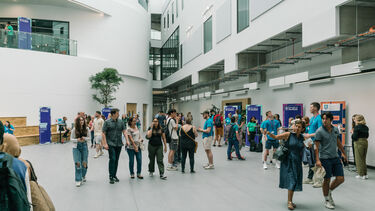Making use of Sheffield's expertise in advanced manufacturing, metal 3D printing and rocket propulsion, the team provided practical feedback to LEAP71’s Managing Director and Co-Founder Josefine Lissner, while developing their Noyron code, which was used to design the engine.
Using Noyron, the company’s Large Computational Engineering Model, meant that the engine was designed autonomously without human intervention and then 3D-printed in copper.
This revolutionary way of designing rocket engines enabled the team to go from preliminary design to a fully manufactured rocket engine in a matter of weeks. The guidance and experience provided by the team at Sheffield ensured that the engine design worked first-time, undergoing a successful day's hot fire at Airborne Engineering in Wescott.
LEAP 71 will use the data from the test to further advance Noyron. The company is working with leading aerospace companies in the US, Europe and Asia on the commercialisation of the resulting rocket engines.
Josefine Lissner, Aerospace engineer, and Managing Director of LEAP 71 said: “This is an important milestone for us, but also for the entire industry. We can now automatically create functional rocket thrusters and directly move to practical validation. From final specification to manufacturing, the design of this engine took less than 2 weeks. In traditional engineering, this would be a task of many months, or even years. Each new engine iteration takes only minutes. Innovation in space propulsion is hard, and costly. With our approach, we hope to make space more accessible for everyone.”
Sheffield took receipt of the engine from 3D print company AMCM and carried out the post processing and preparation for the test, going from print to hot fire in under 2 weeks, thanks to the skilled team in the Mechanical engineering workshop.
The particular liquid Oxygen and liquid Kerosene propellant combination used was similar to that used in the Saturn V rocket engine used to take the Apollo Astronauts to the moon, and is the first time this combination has been used in the UK for a number of years.
It was brilliant working on this exciting project with Sam, Josefine, Lin (co-founder of LEAP71) and the Sheffield team. Advanced engineering design software such as LEAP71’s Noyron capitalises on the rapid and flexible nature of additive manufacturing, which is supporting the rapid growth of the UK and global space propulsion sector. Thanks particularly to Henry Saunders, Oliver Dew and Max Crawford-Collins at Sheffield for their hard work on this project
Dr Alistair John
Deputy Director of Aerospace Engineering at the University of Sheffield
Sheffield has been involved in advanced rocketry and propulsion for nearly a decade, primarily through its student team Project Sunride, who are aiming to be the first UK student team to reach the Karman Line (~100km).
Over the past few years, a sub-group of these students have been working on liquid rocket engines. The Sunfire 2 engine was the first student-built 3D printed liquid rocket engine in the UK, making national headlines. Their next generation engine: Sunfire 3, recently took the crown as most powerful student rocket engine in the UK.
On the back of this success, Aerospace academic Dr Alistair John, and PhD student Henry Saunders set up the national propulsion competition: Race2Space. The aim of this initiative is to open up access to high quality propulsion test facilities for student teams to develop their practical skills, generating high quality employees to boost the UK space sector.


